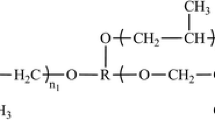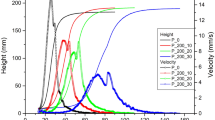Abstract
Rigid polyurethane (PU) foams having saccharide and castor oil structures in the molecular chain were prepared by reaction between reactive alcoholic hydroxyl group and isocyanate. The apparent density of PU foams was in a range from 0.05 to 0.15 g cm−3. Thermal properties of the above polyurethane foams were studied by differential scanning calorimetry, thermogravimetry and thermal conductivity measurement. Glass transitions were observed in two steps. The low-temperature side glass transition was observed at around 220 K, regardless of castor oil content. This transition is attributed to the molecular motion of alkyl chain groups of castor oil. The high-temperature side glass transition observed in the temperature range from 350 to 390 K depends on the amount of molasses polyol content. The high-temperature side glass transition is attributed to the molecular motion of saccharides, such as sucrose, glucose, fructose as well as isocyanate phenyl rings, which act as rigid components. Thermal decomposition was observed in two steps at 570 and 620–670 K. Thermal conductivity was observed at around 0.032 J sec−1 m−1 K−1. Compression strength and modulus of PU foams were obtained by mechanical test. It was confirmed that the thermal and mechanical properties of PU foams could be controlled by changing the mixing ratio of castor oil and molasses for suitable practical applications.











Similar content being viewed by others
References
Ristic IS, Budinski-Simendic J, Krakovsky I, Valentova R, Cakic S, Nikoloic N. The properties of polyurethane hybrid materials based on castor oil. Mater Chem Phys. 2012;132:74–81.
Devia N, Manson JA, Sperling LH, Conde A. Simultaneous interpenetrating networks based on castor oil elastomers and polystyrene. IV. Stress-strain and impact loading behavior. Polym Eng Sci. 1979;19:878–82.
Yenwo GM, Manson JA, Pulido J, Sperling LH, Alfonso C, Napoleón D. Castor-oil-based interpenetrating polymer networks: synthesis and characterization. J Appl Polym Sci. 1977;21:1531–41.
Singh P, Kaushik A. Characterization of castor oil and diphenyl methane diisocyanate-based polyurethane-polystyrene interpenetrating networks. J Reinf Plast Compos. 2005;24:479–1491.
Guo A, Javni I, Petrovic Z. Rigid polyurethane foams based on soybean oil. J Appl Polym Sci. 2000;77:467–73.
Hu YH, Gao Y, Wang DN, Hu CP, Zhu S, Vanoverloop L, Randall D. Rigid polyurethane foam prepared from a rape seed oil based polyol. J Appl Polym Sci. 2002;84:591–7.
Javni I, Petrovic ZS, Gua A, Fuller R. Thermal stability of polyurethanes based on vegetable oils. J Appl Polym Sci. 2000;77:1723–34.
Jin JF, Chen YL, Wang DN, Hu CP, Zhu S, Vanoverloop L, Randall D. Structures and physical properties of rigid polyurethane foam prepared with rosin-based polyol. J Appl Polym Sci. 2002;84:598–604.
John J, Bhattachaiya M, Turner RB. Characterization of polyurethane foams from soybean oil. J Appl Polym Sci. 2002;86:3097.
Kong X, Narine SS. Physical properties of polyurethane plastic sheets produced from polyols from canola oil. Biomacromolecules. 2007;8:2203–9.
Tanaka R, Hirose S, Hatakeyama H. Preparation and characterization of polyurethane foams using a palm oil-based polyol. Bioresour Technol. 2008;99:3810–6.
Tay GS, Nanbo T, Hatakeyama H, Hatakeyama T. Polyurethane composites derived from glycerol and molasses polyols filled with oil palm empty fruit bunches studied by TG and DMA. Thermochim Acta. 2011;525:190–5.
Hatakeyama T, Hatakeyama H. Thermal properties of green polymers and biocomposites. Dordrecht: Kluwer Academic; 2004.
Hatakeyama H, Kosugi R, Hatakeyama T. Thermal properties of lignin- and molasses-based polyurethane foams. J Therm Anal Calorim. 2008;92:419–24.
Hatakeyama H, Marusawa T, Hatakeyema T. Soft type polyurethane derived from molasses. J Mater Sci. 2011;465:7475–81.
Hatakeyama H. Polyurethanes containing lignin. In: Hu TQ, editor. Chemical modification, properties, and usage of lignin. New York: Kluwer Academic/Pleumn Pub; 2002.
Hatakeyama T, Matsumoto Y, Asano Y, Hatakeyama H. Glass transition of rigid polyurethane foams derived from sodium lignosulfonate mixed with diethylene, triethylene and polyethylene glycols. Thermochim Acta. 2004;416:29–33.
Hatakeyama H, Tsujimoto Y, Zarubin MJa, Krutov SM, Hatakeyama T. Thermal decomposition and glass transition of industrial hydrolysis lignin. J Therm Anal Cal. 2010;101:289–95.
Hatakeyama H, Hatakeyama T. Lignin structure, properties and application. Adv Polym Sci. 2010;232:1–63.
Nakamura K, Nishimura Y, Hatakeyama T, Hatakeyama H. Viscoelastic properties of biodegradable polyurethanes derived from coffee grounds. In: Kennedy JF, Phillips GO, Williams PA, editors. The chemistry and processing of wood and plant fibrous materials. Cambridge: Woodhead Pub; 1996.
Kurimot TakedaM, Doi S, Tamura Y, Ono H. Network structures and thermal properties of polyurethane films prepared from liquefied wood. Bioresour Technol. 2001;77:33–40.
Chuayjuljit S, Sangpakdee T, Saravari O. Processing and properties of palm oil-Based rigid polyurethane foam. J Metals Mater Miner. 2007;17:7–23.
Hatakeyama H, Hirose S. (1991) Jpat2611171.
Hatakeyama H, Hirose S. (1997) Jpat2663390.
Hatakeyama T, Quinn FX. Thermal analysis, fundamentals and applications to polymer science. 2nd ed. Chichester: Wiley; 1999.
Momota M, Ozawa T, Kanetsusna H. Thermal analysis of polymer samples by a round robin method Part V thermogravimetry. Thermochim Acta. 1990;159:125–37.
Narine SS, Kong X, Bouzidi L, Sporns P. Physical properties of polyurethanes produced from polyols from seed oils. I-elastomers. J Am Oil Chem Soc. 2007;84:55–63.
Narine SS, Yue J, Kong X. Production of polyols from canola oil and their chemical identification and physical properties. J Am Oil Chem Soc. 2007;84:173–9.
Nguyen T, Zavarin E, Barrall EM II. Thermal analysis of lignocellulosic materials. Part I. Unmodified materials. J Macromol Sci Rev Macromol Chem. 1981;C20:1–65.
Saunders JH, Frisch KC. Polyurethanes, chemistry and technology. New York: Interscience Publishers; 1962.
Acknowledgements
The authors are grateful to Professor Clive S. Langham, Nihon University, for his helpful advice.
Author information
Authors and Affiliations
Corresponding author
Appendix
Appendix
Rights and permissions
About this article
Cite this article
Hatakeyama, H., Matsumura, H. & Hatakeyama, T. Glass transition and thermal degradation of rigid polyurethane foams derived from castor oil–molasses polyols. J Therm Anal Calorim 111, 1545–1552 (2013). https://doi.org/10.1007/s10973-012-2501-5
Received:
Accepted:
Published:
Issue Date:
DOI: https://doi.org/10.1007/s10973-012-2501-5




